
The Arctic Circle is one of the two polar circles, and the most northerly of the five major circles of latitude as shown on maps of Earth at about 66° 34' N. Its southern equivalent is the Antarctic Circle.
The Arctic Circle marks the southernmost latitude at which, on the winter solstice (which is the shortest day of the year) in the Northern Hemisphere, the Sun will not rise all day, and on the Northern Hemisphere's summer solstice (which is the longest day of the year), the Sun will not set. These phenomena are referred to as polar night and midnight sun respectively, and the further north one progresses, the more pronounced these effects become. For example, in the Russian port city of Murmansk, three degrees above the Arctic Circle, the Sun does not rise above the horizon for 40 successive days in midwinter.
The position of the Arctic Circle is not fixed and, taking into account of the nutation, currently runs about 66° 33' 41.800" north of the Equator. Its latitude depends on the Earth's axial tilt, which fluctuates within a margin of more than 2° over a 41,000-year period, owing to tidal forces resulting from the orbit of the Moon. Consequently, the Arctic Circle is currently drifting northwards at a speed of about 14.5 m (48 ft) per year.
Etymology
The word arctic comes from the Greek word ἀρκτικός (arktikos: "near the Bear, northern") and that from the word ἄρκτος (arktos: "bear").
Midnight sun and polar night
Further information: Midnight sun and Polar night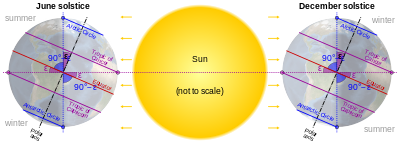
The Arctic Circle is the southernmost latitude in the Northern Hemisphere at which the centre of the Sun can remain continuously above or below the horizon for twenty-four hours; as a result, at least once each year at any location within the Arctic Circle the centre of the Sun is visible at local midnight, and at least once the centre is not visible at local noon.
Directly on the Arctic Circle these events occur, in principle, exactly once per year: at the June and December solstices, respectively. However, because of atmospheric refraction and mirages, and also because the Sun appears as a disk and not a point, part of the midnight sun is visible, on the night of the northern summer solstice, at a latitude of about 50 minutes of arc (′) (90 km (56 mi)) south of the Arctic Circle. Similarly, on the day of the northern winter solstice, part of the Sun may be seen up to about 50′ north of the Arctic Circle. That is true at sea level; those limits increase with elevation above sea level, although in mountainous regions there is often no direct view of the true horizon.
Human habitation

The largest communities north of the Arctic Circle are situated in Russia, Norway, and Sweden: Murmansk (population 295,374) and Norilsk (178,018) in Russia; Tromsø (75,638) in Norway, Vorkuta (58,133) in Russia, Bodø (52,357) and Harstad (24,703) in Norway; and Kiruna, Sweden (22,841). Rovaniemi (62,667) in Finland is the largest settlement in the immediate vicinity of the Arctic Circle, lying 6 km (4 mi) south of the line. Salekhard (51,186) in Russia is the only city in the world located directly on the Arctic Circle.
In contrast, the largest North American community north of the Arctic Circle, Sisimiut (Greenland), has approximately 5,600 inhabitants. In the United States, Utqiagvik, Alaska (formerly known as Barrow) is the largest settlement north of the Arctic Circle with about 5,000 inhabitants. The largest such community in Canada is Inuvik in the Northwest Territories, with 3,137 inhabitants.
Geography
Map all coordinates using OpenStreetMapDownload coordinates as:
The Arctic Circle is roughly 16,000 km (9,900 mi) in circumference. The area north of the Circle is about 20,000,000 km (7,700,000 sq mi) and covers roughly 4% of Earth's surface.
The Arctic Circle passes through the Arctic Ocean, the Scandinavian Peninsula, North Asia, Northern America, and Greenland. The land within the Arctic Circle is divided among eight countries: Norway, Sweden, Finland, Russia, the United States (Alaska), Canada (Yukon, Northwest Territories, and Nunavut), Denmark (Greenland), and Iceland (where it passes through the small offshore island of Grímsey).
Climate
Further information: Climate of the ArcticThe climate north of the Arctic Circle is generally cold, but the coastal areas of Norway have a generally mild climate as a result of the Gulf Stream, which makes the ports of northern Norway and northwest Russia ice-free all year long. In the interior, summers can be quite warm, while winters are extremely cold. For example, summer temperatures in Norilsk, Russia will sometimes reach as high as 30 °C (86 °F), while the winter temperatures frequently fall below −50 °C (−58 °F).
Sites along the Arctic Circle





Starting at the prime meridian and heading eastwards, the Arctic Circle passes through:
Gallery
-
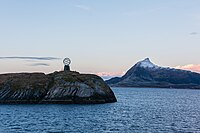 Northern Polar Circle Globe on Vikingen island marking the Arctic Circle in Norway
Northern Polar Circle Globe on Vikingen island marking the Arctic Circle in Norway
-
 Arctic Circle sign by the Inland Line railway, Sweden
Arctic Circle sign by the Inland Line railway, Sweden
-
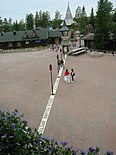 The white borderline of the Arctic Circle at the Santa Claus Village in Rovaniemi, Finland
The white borderline of the Arctic Circle at the Santa Claus Village in Rovaniemi, Finland
-
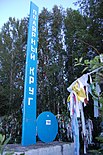 Arctic Circle sign in the Republic of Karelia, Russia
Arctic Circle sign in the Republic of Karelia, Russia
-
Arctic Circle sign by the Yamalo-Nenets Autonomous Okrug, Russia
-
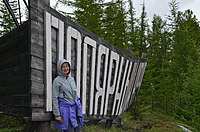 A sign in the Sakha Republic (Yakutia), Russia
A sign in the Sakha Republic (Yakutia), Russia
-
Arctic Circle marker on island of Grímsey in Iceland
-
 A sign along the Dalton Highway marking the location of the Arctic Circle in Alaska, United States
A sign along the Dalton Highway marking the location of the Arctic Circle in Alaska, United States
-
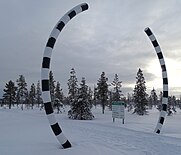 Polcirkeln portal in Gällivare, Sweden
Polcirkeln portal in Gällivare, Sweden
-
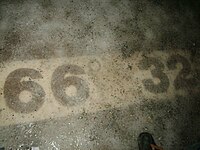 Arctic Circle line in Rovaniemi, Finland c. 1865
Arctic Circle line in Rovaniemi, Finland c. 1865
See also
- 60th parallel north
- Arctic cooperation and politics
- Arctic haze
- Circumpolar star
- Scott Polar Research Institute
- Territorial claims in the Arctic
- Tropic of Cancer
- Tropic of Capricorn
References
- "Arctic FAQ - Frequently Asked Questions about the Arctic".
- "40 days without the sun. How? Polar Night begins in Murmansk". Auroravillage.info. 3 December 2018. Retrieved 24 March 2022.
- Burn, Chris. The Polar Night (PDF). The Aurora Research Institute. Retrieved 28 September 2015.
- N.B.: This refers to the true geometric center which actually appears higher in the sky because of refraction by the atmosphere.
- Berger, A. L. (1976). "Obliquity and Precession for the Last 5000000 Years". Astronomy & Astrophysics. 51 (1): 127–135. Bibcode:1976A&A....51..127B.
- Liddell, Henry; Scott, Robert. "Arktikos". A Greek–English Lexicon. Perseus Digital Library.
- Liddell, Henry; Scott, Robert. "Arktos". A Greek–English Lexicon. Perseus Digital Library.
- Burn, Chris. The Polar Night (PDF). The Aurora Research Institute. Retrieved 28 September 2015.
- Всеволод Липатов (26 April 2011). "Город на Полярном круге". ToGeo.ru (in Russian). Archived from the original on 8 August 2014. Retrieved 23 July 2021.
- Nuttall, Mark (2004). Encyclopedia of the Arctic Volumes 1, 2 and 3. Routledge. p. 115. ISBN 978-1579584368.
- Marsh, William M.; Kaufman, Martin M. (2012). Physical Geography: Great Systems and Global Environments. Cambridge University Press. p. 24. ISBN 978-0-521-76428-5.
External links
- Terra Incognita: Exploration of the Canadian Arctic—Historical essay about early expeditions to the Canadian Arctic, illustrated with maps, photographs and drawings
- Temporal Epoch Calculations ©2006 by James Q. Jacobs Download: Epoch v2009.xls (modify D4)
- Useful constants" See: Obliquity of the ecliptic
| Arctic topics | |
|---|---|
| History | |
| Government | |
| Geography | |
| Geology | |
| Regions | |
| Climate | |
| Fauna | |
| Flora | |
| Culture | |
| Economy | |
| Transport | |
| Circles of latitude / meridians | |
|---|---|
 Equator
Tropic of Cancer
Tropic of Capricorn
Arctic Circle
Antarctic Circle
Equator
Tropic of Cancer
Tropic of Capricorn
Arctic Circle
Antarctic Circle
Equator
Tropic of Cancer
Tropic of Capricorn
Arctic Circle
Antarctic Circle
W0°E
30°
60°
90°
120°
150°
180°
30°
60°
90°
120°
150°
180°
5°
15°
25°
35°
45°
55°
65°
75°
85°
95°
105°
115°
125°
135°
145°
155°
165°
175°
5°
15°
25°
35°
45°
55°
65°
75°
85°
95°
105°
115°
125°
135°
145°
155°
165°
175°
10°
20°
40°
50°
70°
80°
100°
110°
130°
140°
160°
170°
10°
20°
40°
50°
70°
80°
100°
110°
130°
140°
160°
170°
0°
10°
20°
30°
40°
50°
60°
70°
80°
90°
10°
20°
30°
40°
50°
60°
70°
80°
90°
5° N
15°
25°
35°
45°
55°
65°
75°
85°
5° S
15°
25°
35°
45°
55°
65°
75°
85°
45x90
45x90
45x90
45x90
Equator
Tropic of Cancer
Tropic of Capricorn
Arctic Circle
Antarctic Circle
Equator
Tropic of Cancer
Tropic of Capricorn
Arctic Circle
Antarctic Circle
Equator
Tropic of Cancer
Tropic of Capricorn
Arctic Circle
Antarctic Circle
W0°E
30°
60°
90°
120°
150°
180°
30°
60°
90°
120°
150°
180°
5°
15°
25°
35°
45°
55°
65°
75°
85°
95°
105°
115°
125°
135°
145°
155°
165°
175°
5°
15°
25°
35°
45°
55°
65°
75°
85°
95°
105°
115°
125°
135°
145°
155°
165°
175°
10°
20°
40°
50°
70°
80°
100°
110°
130°
140°
160°
170°
10°
20°
40°
50°
70°
80°
100°
110°
130°
140°
160°
170°
0°
10°
20°
30°
40°
50°
60°
70°
80°
90°
10°
20°
30°
40°
50°
60°
70°
80°
90°
5° N
15°
25°
35°
45°
55°
65°
75°
85°
5° S
15°
25°
35°
45°
55°
65°
75°
85°
45x90
45x90
45x90
45x90
|